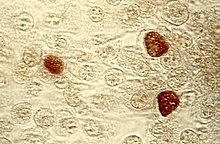Chlamydiae
| Chlamydiae | |
|---|---|
 |
|
| Chlamydia trachomatis | |
| Scientific classification | |
| Domain: | Bacteria |
| Phylum: |
Chlamydiae Garrity & Holt 2012 |
| Class: |
Chlamydiia Gupta et al. 2016 |
| Orders and families | |
|
|
| Synonyms | |
|
|
The Chlamydiae are bacterial phylum and class whose members are obligate intracellular pathogens. They are ovoid in shape and stain Gram-negative. Historically it was believed that all Chlamydiae species had a peptidoglycan-free cell wall, but recent work demonstrates a detectable presence of peptidoglycan, as well as other important proteins. Many species belonging to this order are susceptible to antimicrobial agents. All known Chlamydiae only grow by infecting eukaryotic host cells. They are as small as or smaller than many viruses. They are dependent on replication inside the host cells, thus are termed obligate intracellular pathogens. Most intracellular Chlamydiae are located in an inclusion body or vacuole. Outside of cells, they survive only as an extracellular infectious form. Chlamydiae can grow only where their host cells grow, and develop according to a characteristic biphasic developmental cycle. Therefore, Chlamydiae cannot be propagated in bacterial culture media in the clinical laboratory. Chlamydiae are most successfully isolated while still inside their host cells.
Chlamydia-like disease affecting the eyes of people was first described in ancient Chinese and Egyptian manuscripts. A modern description of chlamydia-like organisms was provided by Halberstaedrrter and von Prowazek in 1907. Chlamydial isolates cultured in the yolk sacs of embryonating eggs were obtained from a human pneumonitis outbreak in the late 1920s and early 1930s, and by the mid-20th century, isolates had been obtained from dozens of vertebrate species. The term 'chlamydia' (a cloak) appeared in the literature in 1945, although other names continued to be used, including Bedsonia, Miyagawanella, ornithosis-, TRIC-, and PLT-agents.
In 1966, Chlamydiae were recognized as bacteria and the genus Chlamydia was validated. The order Chlamydiales was created by Storz and Page in 1971. The class Chlamydiia was recently validly published. Between 1989 and 1999, new families, genera, and species were recognized. The phylum Chlamydiae was established in Bergey's Manual of Systematic Bacteriology. By 2006, genetic data for over 350 chlamydial lineages had been reported,
...
Wikipedia
